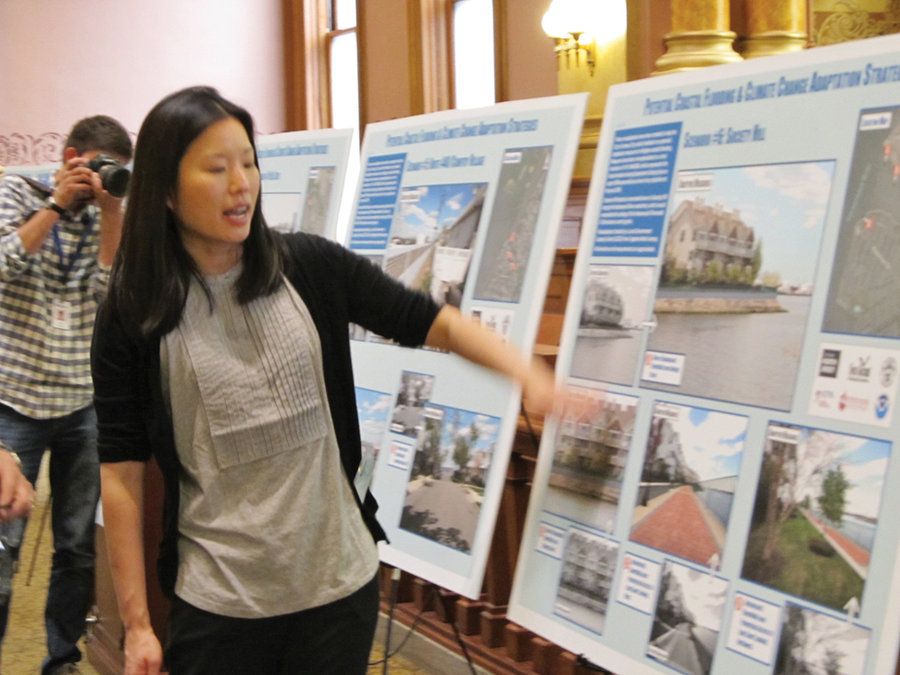Superstorm Sandy produced the worst local flooding than any storm in recorded history, according to findings presented July 30 in Jersey City at a forum at City Hall. But even without a catastrophic hurricane, climate change and rising sea levels pose serious risks to low-lying portions of Hudson County unless preventive action is taken.
That’s the conclusion of a study done by scientists from the Stevens Institute of Technology in collaboration with the Division of City Planning.
Funded by a National Oceanic and Atmospheric Administration (NOAA) Sea Grant, the study broke down Jersey City into areas of concern and recommended ways to alleviate flood danger from both storm surges and rising sea levels over the next half century.
“At this forum, we are continuing our open dialogue with the public so we may develop additional strategies and solutions to prevent potential flooding and damage to our communities,” said Mayor Steven Fulop.
The study was done in response to Sandy’s devastation, with the understanding that future storms will be more frequent and intense. The study is an early phase of a long-term effort to identify and implement preventive measures.
Urban flooding in Hudson County is a relatively modern occurrence. During the 19th century, there were very few floods of the kind commonly felt over the last few decades, but Hudson County and Jersey City have seen significant storm surges since the early 1990s.
Some of the proposed solutions involve building berms or walls, while officials said the best solution would be to require new development to be built higher to be less affected by floods.
Tidal gates, levees, and raising streets were some of the proposals, although officials said these were only some suggestions, and did not come with an estimated cost, nor did the study take into account all possibilities.
Will a wall hold back the surge?
Some residents who spoke at the question and answer session were concerned about proposals to construct permanent flood barriers. They asked about temporary walls which would automatically rise in place to keep out rising water. But such gates are risky, officials noted. If one section failed, like the broken levees in New Orleans during Hurricane Katrina, flood water would simply go through the break. And putting up temporary walls would be a logistical nightmare for workers carting them to needed locations ahead of the threatened high water.
“We are continuing our open dialogue with the public so we may develop additional strategies and solutions.” – Mayor Steven Fulop.
____________
During the Sandy flooding, nearly all of the northern section of Liberty State Park was underwater. Raising the land near Jersey Avenue would guard against flooding there. Raising street levels around Washington Street would help stop flooding there, as would a similar strategy near Route 440 and Country Village, which saw some of the most significant flooding in the city during Sandy as water flowed over the banks of Newark Bay and the Hackensack River.
Overall the study presentation showed six visualizations of 27 potential adaption measures.
While there were many flood mitigation options, this study focused only on a few, such as vertical solutions that included things like berms and levees. But organizers said that there should be a layered approach that included zoning changes that would allow for projects to be built on heights or with other solutions that would reduce the impact of flooding. The study also said that a regional approach should also be developed since flooding crosses municipal and other boundaries.
For instance, the study noted that if all of the suggested flooding improvements were made in Jersey City, nearby Hoboken would see significantly less flooding, especially near its southern portion.
Jersey City was also awarded funds from the North Jersey Planning Authority and Together North Jersey’s Local Government Capacity grant program to develop potential adaptation measures, and a framework for a cost-benefit analysis to show the savings in property damage if the changes are implemented.
The city intends to follow up this study with a professional development conference in September, during which Baker Engineering, which was involved in the current study, will provide some of the cost analysis, and possible estimates to implement some of these recommendations.
This study is unrelated to Rebuild by Design which is a comprehensive water management project that will protect Hoboken, Weehawken and northern Jersey City has won $230 million of federal funding.
Al Sullivan may be reached at asullivan@hudsonreporter.com.
